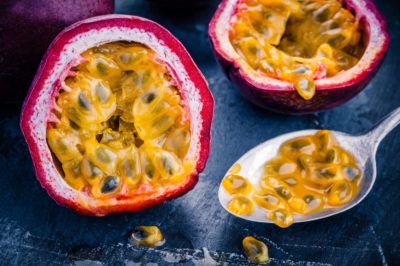Purple and Yellow Passion Fruit
If you live in a subtropical climate, you’re probably growing purple passion fruit, but this plant also comes in yellow varieties. Purple passion fruit doesn’t get as much frost damage as the golden passion fruit. Purple varieties are popular for growing in California, Hawaii and southern Florida. Both of these fruits produce delicious juice and fruit, but the purple one is the most flavorful if you’re eating it fresh off the vine.
How to Tell When the Fruit Is Ripe
The easiest way to tell when your passion fruit is ripe is when it falls off the vines. If you’re selecting yours from the store, then there are physical characteristics to look for when choosing your passion fruit.
- Slightly wrinkled and plump
- Purple or yellow color
- Feels heavy
If your passion fruit is still green with smooth skin, then it’s not ripe yet. Green fruit is very tart, so ripen them at room temperature for three to five days. As the fruit ages, the sweeter it gets. You’ll be glad you waited a few days for the sweet, tropical taste of ripe passion fruit.
How to Eat Passion Fruit
Once you’ve selected fully ripe fruit, cut it in half. Spoon out the fruit and seeds. You can eat both of them, but remove the film that forms around the outside of the seeds. It is edible but it doesn’t taste very good.
Some people prefer to remove the seeds for a seedless pulp. If you decide to do that, you can use a sieve to press out the juice and pulp, leaving the seeds behind.
If you have a sweet tooth, add some sugar, whipped cream or ice cream to the top of the passion fruit. You’ll get about one cup of pulp from ten to twelve passion fruits. One liter of juice requires about 100 fruits.
How to Store Passion Fruit
Place your passion fruit in a bag and store it in the refrigerator for about two days. If you want to keep your fruit for a longer time, remove the pulp and put it in a freezer bag or container. You can freeze it for up to one year.
